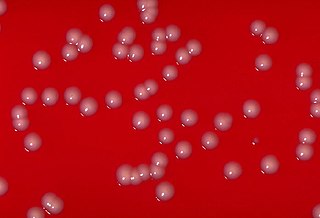Related Research Articles

Corynebacterium is a genus of bacteria that are Gram-positive and aerobic. They are bacilli (rod-shaped), and in some phases of life they are, more particularly, club-shaped, which inspired the genus name.
Aggregatibacter actinomycetemcomitans is a Gram-negative, facultative anaerobe, nonmotile bacterium that is often found in association with localized aggressive periodontitis, a severe infection of the periodontium. It is also suspected to be involved in chronic periodontitis. Less frequently, A. actinomycetemcomitans is associated with nonoral infections such as endocarditis. Its role in aggressive periodontitis was first discovered by Danish-born periodontist Jørgen Slots, a professor of dentistry and microbiology at the University of Southern California School of Dentistry.
Sakacins are bacteriocins produced by Lactobacillus sakei. They are often clustered with the other lactic acid bacteriocins. The best known sakacins are sakacin A, G, K, P, and Q. In particular, sakacin A and P have been well characterized.
Latilactobacillus sakei is the type species of the genus Latilactobacillus that was previously classified in the genus Lactobacillus. It is homofermentative; hexoses are metabolized via Glycolysis to lactic acid as main metabolite; pentoses are fermented via the Phosphoketolase pathway to lactic and acetic acids.
Weissella hellenica is a species of Gram-positive bacteria, placed within the family of Leuconostocaceae. It is frequently isolated from fermented sausage and flounder intestine, as well as Korean fermented pickle Kimchi and barrels used to make Japanese pickles. Some strains have been observed to be probiotic while some have not. Some strains produce bacteriocins named weissellicins which show antimicrobial activity against other bacteria.
Vibrio fluvialis is a water-borne bacterium first isolated from patients with severe diarrhoea in Bahrain in the 1970s by A. L. Furniss and his colleagues, and is considered to be an emerging pathogen with the potential to have a significant impact on public health. Upon discovery, this organism was considered to be similar to both Vibrio and Aeromonas species, but was ultimately determined to be more closely related to Vibrio. V. fluvialis can be found in salt waters globally and also has the potential to infect both humans and a variety of crustaceans.
Providencia rettgeri, is a Gram negative bacterium that is commonly found in both water and land environments. P. rettgeri is in the genus Providencia, along with Providencia stuartii, Providencia alcalifaciens, and Providencia rustigianii. P. rettgeri can be incubated at 37 °C in nutrient agar or nutrient broth. It was first discovered in 1904 after a waterfowl epidemic. Strains of the species have also been isolated from nematodes of the genus Heterorhabditis.
Aeromonas media is a species of bacteria. RM is the type strain of this species.
Enterococcus hirae is a species of Enterococcus. Its type strain is NCDO 1258. It is involved in growth depression in young chickens and endocarditis and sepsis in humans.
Yersinia kristensenii is a species of bacteria. It is Gram-negative and its type strain is 105. It is potentially infectious to mice. It secretes a bacteriocin that targets related species.
Vibrio furnissii is a Gram-negative, rod-shaped bacterium. Its type strain is ATCC 35016. V. furnissii is aerogenic, and uses L-rhamnose, L-arginine, L-arabinose, maltose, and D-mannitol, but not L-lysine, L-ornithine, or lactose. It has been isolated from patients with gastroenteritis, bacteremia, skin lesions, and sepsis.
Lactococcus piscium is a known fish pathogen affecting salmonid fish, which has nevertheless been found in other sources, such as packaged beef. Its type strain is NCFB 2778. L. piscium has shown promise as a bioprotective culture in the preservation of seafood. The bacterium has exhibited the ability to prevent sensory deterioration of food and inhibit the growth of other psychrophilic bacteria that may produce spoilage.
Lactobacillus mucosae is a rod shaped species of lactic acid bacteria first isolated from pig intestines. It has mucus-binding activity. The species is an obligate anaerobe, catalase-negative, doesn't form spores and is non-motile. Its type strain is S32T, and has been found to be most closely related to Lactobacillus reuteri.
Bacillus sporothermodurans is a species of bacteria notable for producing highly heat-resistant endospores, hence its name. It is strictly aerobic. Its type strain is M215.
Tetragenococcus muriaticus is a species of moderately halophilic lactic acid, histamine-producing bacteria. X-1 is the type strain of this species.
Leuconostoc gelidum is a Gram-positive lactic acid bacterium; its type strain is NCFB 2775. Its genome has been sequenced. Its name derives from the fact that it was first isolated from chill-stored meats.
Vagococcus salmoninarum is a species of bacteria, with type strain NCFB 2777. It is pathogenic towards Oncorhynchus mykiss.
Cereins are a group of bacteriocins produced by various strains of the bacterium Bacillus cereus. Although all cereins are by definition produced by B. cereus, it is possible that they are chemically quite different from one another. Cereins have been found to be active against other strains of B. cereus, as well as a broad range of other gram-positive bacteria. Like other bacteriocins, cereins are generally named after the strain in which their production was first discovered. Named cereins include cerein 7, cerein 7B, cerein 8A, and cerein MRX1.
Vagococcus is a genus of gram-positive bacteria. They are motile or nonmotile cocci which do not form spores. The name Vagococcus comes from Latin adjective vagus meaning wandering; and the Greek noun coccus a grain or berry, Vagococcus - wandering coccus, because Vagococcus fluvialis and some other Vagococcus species are motile, an unusual property for a lactic acid bacteria.
Tenacibaculum is a Gram-negative and motile bacterial genus from the family of Flavobacteriaceae.
References
- ↑ Collins, M.D.; Ash, C.; Farrow, J.A.E.; Wallbanks, S.; Williams, A.M. (1989). "16S Ribosomal ribonucleic acid sequence analyses of lactococci and related taxa. Description ofVagococcus fluvialisgen. nov., sp. nov". Journal of Applied Bacteriology. 67 (4): 453–460. doi:10.1111/j.1365-2672.1989.tb02516.x. ISSN 0021-8847. PMID 2479630.
- ↑ Jadhav, Kartik Pandurang; Pai, Praveen G (October 2019). "A rare infective endocarditis caused by Vagococcus fluvialis". Journal of Cardiology Cases. 20 (4): 129–131. doi: 10.1016/j.jccase.2019.07.001 . PMC 6962713 . PMID 31969941.